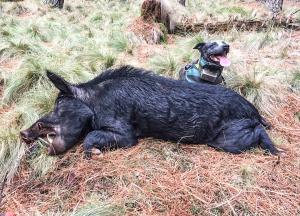Uhunt
The History of the Stumpy Tail Cattle Dog
Uhunt Mag Information
- Posted By : BRISTLE UP
- Posted On : Jun 30, 2019
- Views : 3037
- Likes : 2
- Category : PIG DOGGING » ARTICLES, TIPS & HOW TO GUIDES
- Description : "The Australian Stumpy Tail Cattle Dog or “Stumpy” as we call them are often mixed up with the Australian Cattle Dog."
Overview
- By Harley Sampson
The Australian Stumpy Tail Cattle Dog or “Stumpy” as we call them are often mixed up with the Australian Cattle Dog. Obviously they look similar and the main feature to tell them apart is clearly the stumpy tail. But these are actually two distinctly different breeds.
Australian stumpy tail cattle dog
Some of you may not know that both breeds are a mixture of breeds created back in the 1800s to bring a breed to Australia that would withstand the harsh conditions. They began evolving the breed for the Stumpys in the early 1830s the breed that is around today is the result of many years of selective breeding. Three breeds of dog went into the making of the Stumpy. First there was the crossing of the Dingo with an English breed of dog called the Smithfield, these dogs were naturally bob-tailed which is where the gene comes from that is still present in the Stumpy today. From there the progeny from these mating’s were crossed with the smooth coated blue merle Collieor commonly referred to today as the German Coolie and this is how the breed was born. Though there is a big difference between the 2 breeds the Stumpys are also squarer with a shorter back, a lighter body, wedge-shaped head, and longer legs than the cattle dog. The stumpy also does not have the tan color or patches. Stumpys are often used for cattle work for their hard biting and their ability to with stand long periods of work in any condition. They are loyal and devoted dogs with a natural drive to work cattle, but they can also be trained to chase pigs. Always alert, obedient and suspicious of strangers.
After getting my first stumpy from my cousin 7 years ago, that was when I realized how different they are to the cattle dog. My cousin has been breeding the Stumpys for a long time though many breeders use them for showing, this line isn’t from show lines as they are all station bred dogs that he has sourced from all over the country for many years to create his own line. As far as using them for pig dogs, they are probably not the best out there, but they definitely do the job for me. and I think the Stumpys suit this for me. Obviously every breed won’t suit everyone, and Stumpys wont suit for chiller work as they are extremely hard backend biters. This is a great trait for a bailer though as soft bailers can have a lot of trouble pulling a pig up by themselves. I would call them close to medium finders and they mainly bail but do like a scrap when given the chance. I have found they are very intelligent dogs, so they will pretty much do whatever the situation needs.
For example, if it’s hot or they are tired then they will bail, if you’re in a tight spot and you need them to hold they can and will. Though I have come to like the breed over the years, I have realized that they need to be socialized from a young age with everything around them. They aren’t a breed you can keep in town in a small yard. They have a very protective nature even more so when it comes to family & there home. The down side to this is they will bite strangers if they aren’t being watched as this is just their trait and unfortunately can be hard to change.
Australian cattle dog
The Australian Cattle Dog have tails, have a short and stocky body with tan cheeks and feet. Their breed is the outcome of deliberate breeding also. In the process of breeding the first Australia Cattle Dog, various dogs with specific abilities were crossbred over a period of 60 years. During the 1830’s a collie type dog was crossed with the wild Dingo. The result was a dog, believed to be called Timmon’s Biters, that barked less and was better at driving the herds. In the 1840s 2 blue-merle smooth coated collies were crossed with the Dingo. The dogs out of this litter were known as Hall’s Heelers. Timmon’s Biters, Hall’s Heelers and Dingoes were used in further breeding experiments. One experiment involved a male Dingo being bred with a blue merle collie. A Dalmatian was then introduced which made the breed good with horses but not as good at herding. The Bull Terrier was then added but made the dogs too rough so the breed was bred out. Later on they crossed them with the black and tan kelpie. The final result was a compact dog, similar in build to the dingo, but thicker set. This was the final dog to be used in the breeding programme and the Australian cattle dog has been bred true since 1893 with both blue and red varieties now common in a litter. By the late 1800s, the breed was widely recognized and standardized in Australia. The Australian cattle dog was accepted for American Kennel Club (AKC) registration in 1980. Both breeds are well sort after due to their drive and work ethic on cattle.
